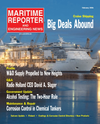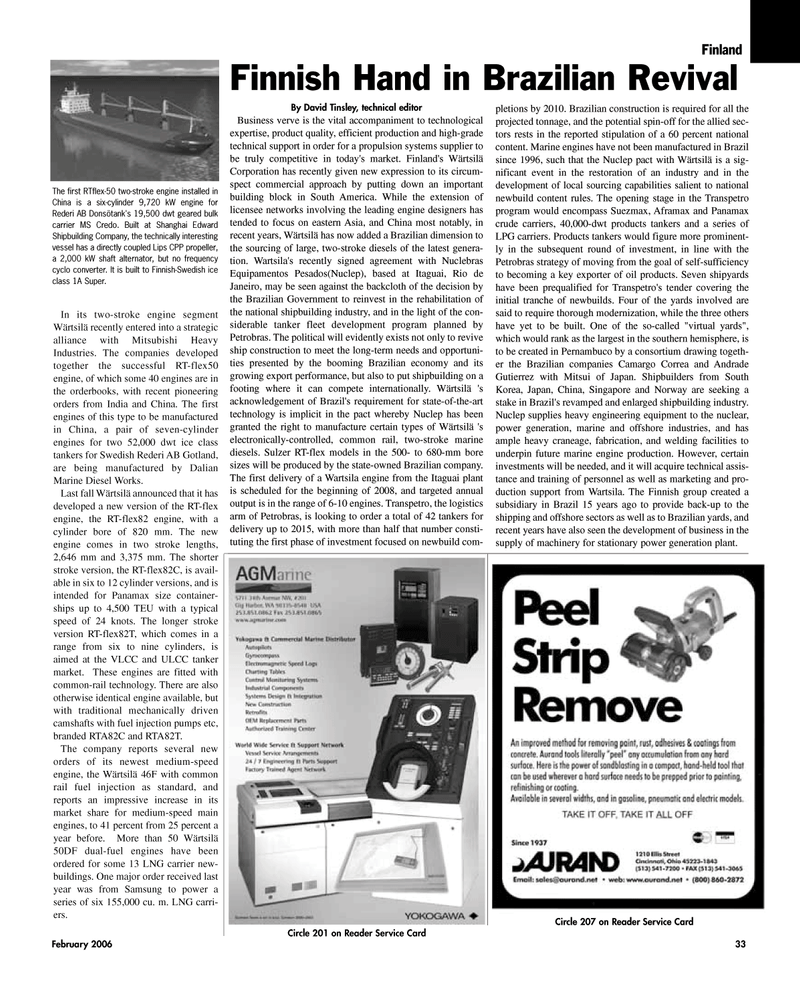
Page 33: of Maritime Reporter Magazine (February 2, 2006)
Read this page in Pdf, Flash or Html5 edition of February 2, 2006 Maritime Reporter Magazine
February 2006 33
Finland
In its two-stroke engine segment
Wärtsilä recently entered into a strategic alliance with Mitsubishi Heavy
Industries. The companies developed together the successful RT-flex50 engine, of which some 40 engines are in the orderbooks, with recent pioneering orders from India and China. The first engines of this type to be manufactured in China, a pair of seven-cylinder engines for two 52,000 dwt ice class tankers for Swedish Rederi AB Gotland, are being manufactured by Dalian
Marine Diesel Works.
Last fall Wärtsilä announced that it has developed a new version of the RT-flex engine, the RT-flex82 engine, with a cylinder bore of 820 mm. The new engine comes in two stroke lengths, 2,646 mm and 3,375 mm. The shorter stroke version, the RT-flex82C, is avail- able in six to 12 cylinder versions, and is intended for Panamax size container- ships up to 4,500 TEU with a typical speed of 24 knots. The longer stroke version RT-flex82T, which comes in a range from six to nine cylinders, is aimed at the VLCC and ULCC tanker market. These engines are fitted with common-rail technology. There are also otherwise identical engine available, but with traditional mechanically driven camshafts with fuel injection pumps etc, branded RTA82C and RTA82T.
The company reports several new orders of its newest medium-speed engine, the Wärtsilä 46F with common rail fuel injection as standard, and reports an impressive increase in its market share for medium-speed main engines, to 41 percent from 25 percent a year before. More than 50 Wärtsilä 50DF dual-fuel engines have been ordered for some 13 LNG carrier new- buildings. One major order received last year was from Samsung to power a series of six 155,000 cu. m. LNG carri- ers.
The first RTflex-50 two-stroke engine installed in
China is a six-cylinder 9,720 kW engine for
Rederi AB Donsötank's 19,500 dwt geared bulk carrier MS Credo. Built at Shanghai Edward
Shipbuilding Company, the technically interesting vessel has a directly coupled Lips CPP propeller, a 2,000 kW shaft alternator, but no frequency cyclo converter. It is built to Finnish-Swedish ice class 1A Super.
By David Tinsley, technical editor
Business verve is the vital accompaniment to technological expertise, product quality, efficient production and high-grade technical support in order for a propulsion systems supplier to be truly competitive in today's market. Finland's Wärtsilä
Corporation has recently given new expression to its circum- spect commercial approach by putting down an important building block in South America. While the extension of licensee networks involving the leading engine designers has tended to focus on eastern Asia, and China most notably, in recent years, Wärtsilä has now added a Brazilian dimension to the sourcing of large, two-stroke diesels of the latest genera- tion. Wartsila's recently signed agreement with Nuclebras
Equipamentos Pesados(Nuclep), based at Itaguai, Rio de
Janeiro, may be seen against the backcloth of the decision by the Brazilian Government to reinvest in the rehabilitation of the national shipbuilding industry, and in the light of the con- siderable tanker fleet development program planned by
Petrobras. The political will evidently exists not only to revive ship construction to meet the long-term needs and opportuni- ties presented by the booming Brazilian economy and its growing export performance, but also to put shipbuilding on a footing where it can compete internationally. Wärtsilä 's acknowledgement of Brazil's requirement for state-of-the-art technology is implicit in the pact whereby Nuclep has been granted the right to manufacture certain types of Wärtsilä 's electronically-controlled, common rail, two-stroke marine diesels. Sulzer RT-flex models in the 500- to 680-mm bore sizes will be produced by the state-owned Brazilian company.
The first delivery of a Wartsila engine from the Itaguai plant is scheduled for the beginning of 2008, and targeted annual output is in the range of 6-10 engines. Transpetro, the logistics arm of Petrobras, is looking to order a total of 42 tankers for delivery up to 2015, with more than half that number consti- tuting the first phase of investment focused on newbuild com- pletions by 2010. Brazilian construction is required for all the projected tonnage, and the potential spin-off for the allied sec- tors rests in the reported stipulation of a 60 percent national content. Marine engines have not been manufactured in Brazil since 1996, such that the Nuclep pact with Wärtsilä is a sig- nificant event in the restoration of an industry and in the development of local sourcing capabilities salient to national newbuild content rules. The opening stage in the Transpetro program would encompass Suezmax, Aframax and Panamax crude carriers, 40,000-dwt products tankers and a series of
LPG carriers. Products tankers would figure more prominent- ly in the subsequent round of investment, in line with the
Petrobras strategy of moving from the goal of self-sufficiency to becoming a key exporter of oil products. Seven shipyards have been prequalified for Transpetro's tender covering the initial tranche of newbuilds. Four of the yards involved are said to require thorough modernization, while the three others have yet to be built. One of the so-called "virtual yards", which would rank as the largest in the southern hemisphere, is to be created in Pernambuco by a consortium drawing togeth- er the Brazilian companies Camargo Correa and Andrade
Gutierrez with Mitsui of Japan. Shipbuilders from South
Korea, Japan, China, Singapore and Norway are seeking a stake in Brazil's revamped and enlarged shipbuilding industry.
Nuclep supplies heavy engineering equipment to the nuclear, power generation, marine and offshore industries, and has ample heavy craneage, fabrication, and welding facilities to underpin future marine engine production. However, certain investments will be needed, and it will acquire technical assis- tance and training of personnel as well as marketing and pro- duction support from Wartsila. The Finnish group created a subsidiary in Brazil 15 years ago to provide back-up to the shipping and offshore sectors as well as to Brazilian yards, and recent years have also seen the development of business in the supply of machinery for stationary power generation plant.
Finnish Hand in Brazilian Revival
Circle 201 on Reader Service Card
Circle 207 on Reader Service Card
MR FEBRUARY2006 #5 (33-40).qxd 2/2/2006 2:52 PM Page 33

 32
32

 34
34
